Are you looking for an old coin made of silver? If yes, then you need to consider getting the 1952 silver quarter. It is already more than 70 years old and carries a great numismatic and sentimental value.
So, if you wish to learn more about the 1952 silver quarter, then you need to read through this post.
What Is the 1952 Washington Silver Quarter Made Of?
The 1952 Washington quarter is made of 90% silver and 10% copper. The 1952 quarter is part of the Washington series. Except for 1933, the US Mint produced these coins starting in 1932 to the present.
Now, you might wonder, why was there no Washington quarter in 1933. Well, the answer is that originally, the US Mint planned to only produce the Washington quarter in a single year, which is 1932. That was the year that would have been the 200th birth anniversary of George Washington.
However, in 1932, the Washington quarter became unexpectedly popular with the public. Thus, the US Mint decided to continue minting the Washington quarter and permanently replace the Standing Liberty quarter.
From 1932 to 1964, the Washington quarter had silver in it. However, by virtue of the Coinage Act of 1965, regular US coins, including the Washington quarter, transitioned to base metals. That’s why, starting in 1965 up to the present time, the Washington quarter is made of copper and nickel.
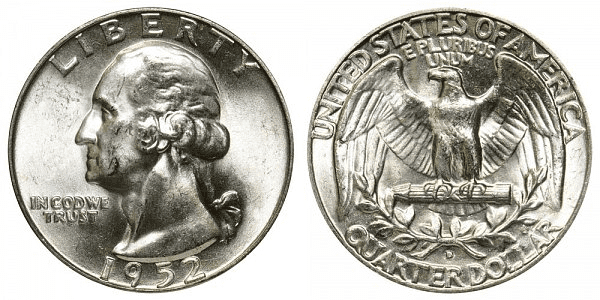
When it comes to design, the obverse features the image of George Washington, the first president of the United States. On the reverse, you’ll find the heraldic eagle with its wings outspread. Aside from that, you’ll find a bundle of arrows, which the eagle clings to. Then, you’ll find olive branches as well.
The specifications of the 1952 Washington silver are as follow:
- Value – 25 cents
- Weight – 6.30 grams
- Diameter – 24.30 millimeters
- Reeded edge
1952 Washington Silver Quarter Varieties
There are three 1952 Washington silver quarter varieties. In terms of design, they are not really that different from each other. The main difference is their mint mark and whether they are proof coins or not.
Here’s a quick look at the different varieties of the 1952 Washington silver quarter and their mintage:
| Variety | Mint Location | Mintage |
| 1952 D Washington quarter | Denver | 49,795,200 |
| 1952 S Washington quarter | San Francisco | 13,707,800 |
| 1952 P Washington quarter | Philadelphia | 38,780,093 |
| 1952 Proof Washington quarter | Philadelphia | 81,980 |
| Total | 102,365,073 |
Let’s now take a deeper look at each of these quarter varieties.
1952 D Washington Quarter
Year of minting: 1952
Mint Mark: D
Place of minting: Denver
Quantity produced: 49,795,200
Face Value: $0.25 (twenty-five cents)
Price: starts at around $4.45 and $7 (circulated condition)
Mass: 6.30 grams
Edge: Reeded
Designer: John Flanagan
Composition: 90% Silver and 10% Copper
Diameter: 24.30 mm
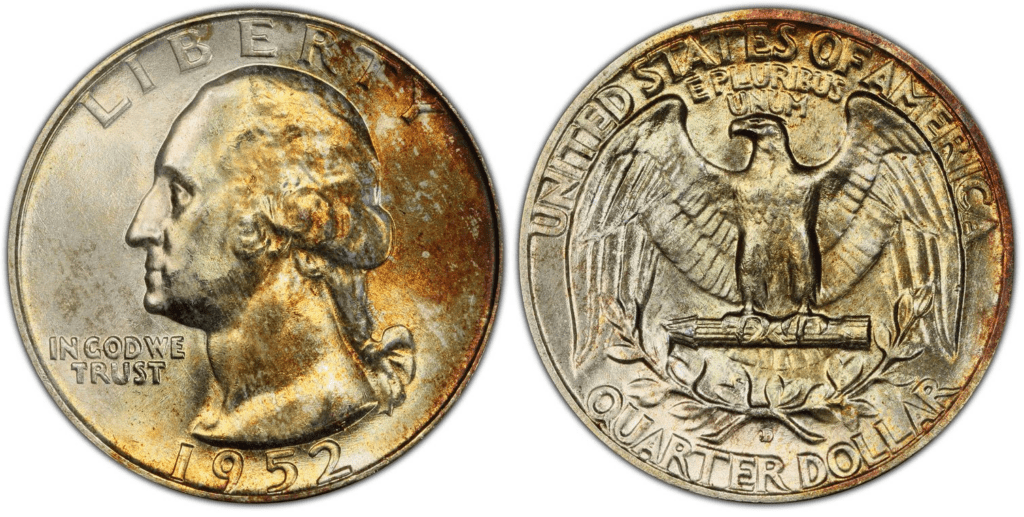
The Denver Mint produced almost 50 million 1952 silver quarters. They yielded the highest production for the quarters in 1952, surpassing the mintage of the Philadelphia and San Francisco Mint.
1952 S Washington Quarter
Year of minting: 1952
Mint Mark: S
Place of minting: San Francisco
Quantity produced: 13,707,800
Face Value: $0.25 (twenty-five cents)
Price: starts at around $4.45 and $7 (circulated condition)
Mass: 6.30 grams
Edge: Reeded
Designer: John Flanagan
Composition: 90% Silver and 10% Copper
Diameter: 24.30 mm
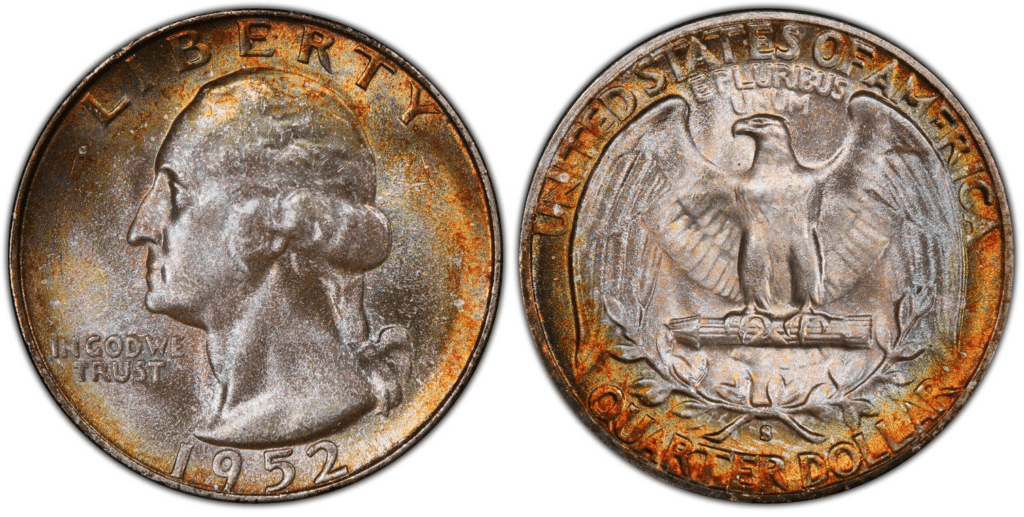
The San Francisco Mint helped in adding more quarter coins in 1952. They produced more than 13 million and the quarters they produced have the S mint mark.
If you’re looking for 1952 S quarters in Mint State, you should easily find them up to a grade of MS 67. Nevertheless, the 1952 S quarters aren’t too detailed, rather they feature a blurry and soft look. This is due to the use of worn-out dies.
1952 P Washington Quarter
Year of minting: 1952
Mint Mark: S
Place of minting: San Francisco
Quantity produced: 38,780,093
Face Value: $0.25 (twenty-five cents)
Price: starts at around $4.45 and $7 (circulated condition)
Mass: 6.30 grams
Edge: Reeded
Designer: John Flanagan
Composition: 90% Silver and 10% Copper
Diameter: 24.30 mm
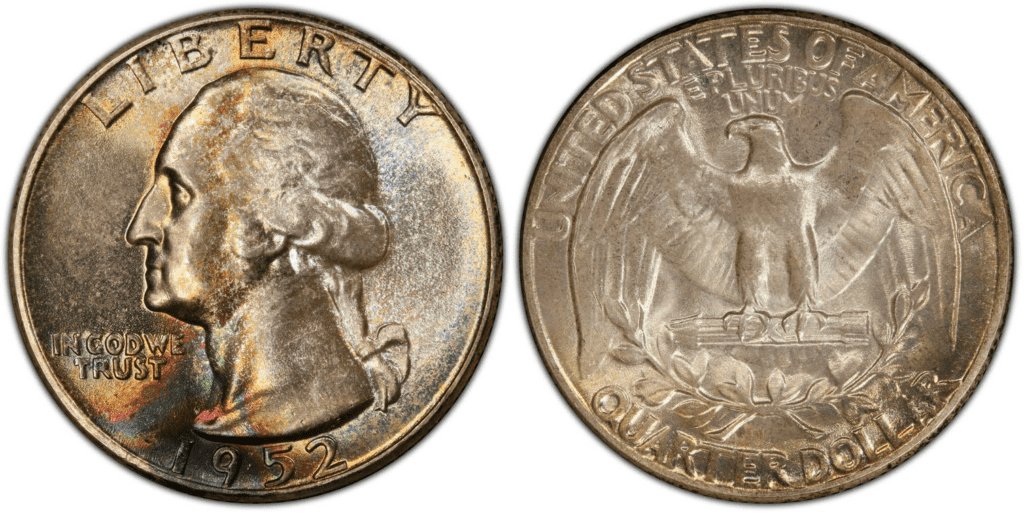
The Philadelphia Mint produced more than 38 million quarters in 1952. Usually, it is the Philadelphia Mint that produces the most coins in a given year. However, more and more people are moving toward the west and the demand for coins from this mint dipped down.
Aside from that, the San Francisco Mint’s limited production capabilities forced the Denver Mint to produce more.
1952 Proof Washington Quarter
Year of minting: 1952
Mint Mark: S
Place of minting: San Francisco
Quantity produced: 81,980
Face Value: $0.25 (twenty-five cents)
Price: starts at around $13 (uncirculated condition)
Mass: 6.30 grams
Edge: Reeded
Designer: John Flanagan
Composition: 90% Silver and 10% Copper
Diameter: 24.30 mm

Aside from regular quarters, the Philadelphia Mint also produced almost 82 thousand proof coins in 1952. Proof coins are made for collectors and not for circulation. That explains why the mintage is so low compared to the mintage figures of regular coins.
List Of 1952 Washington Silver Quarter Errors
With more than 102 million Washington quarters produced in 1952, it is not surprising to see that there were error coins that came out of the mint centers. Yes, error coins are mostly accidentally produced. However, they can sell for a few more dollars than the regular circulated quarters because of their uniqueness.
With that, you may want to learn more about the error coins for the 1952 Washington silver quarters.
Lamination error
The 1952 quarter is made of silver and copper. However, when a foreign material gets into the mix, the whole composition isn’t compatible with each other. As a result, once the coin cools down, you may find cracking or peeling on the surface of the coin.
Here’s an example of a lamination error in a 1952 silver quarter coin:
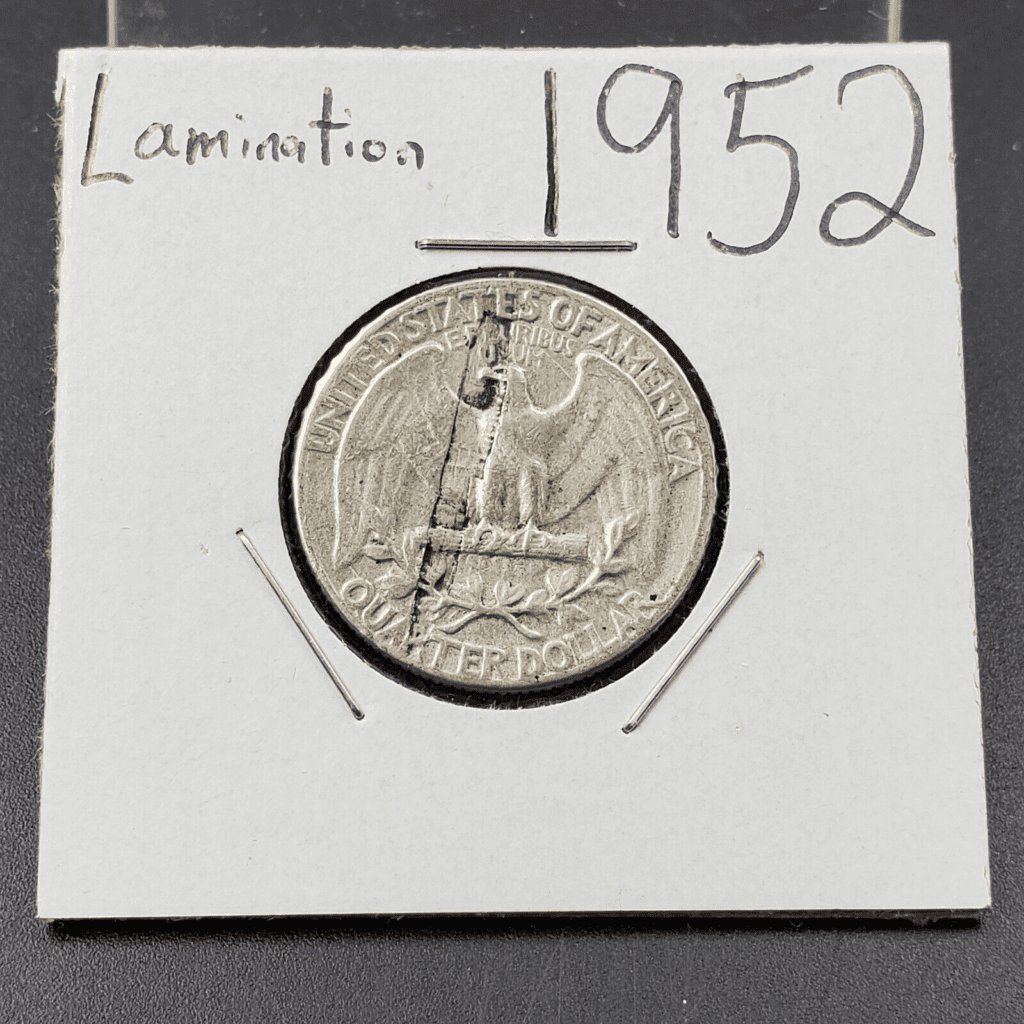
Die crack error
Because of multiple strikes, the die may eventually break. When this happens, the crack on the die would also be stamped on the blank coin. As a result, you would see unintended lines and marks on the coin.
Here’s an example of a die crack error on a 1952 silver quarter coin:
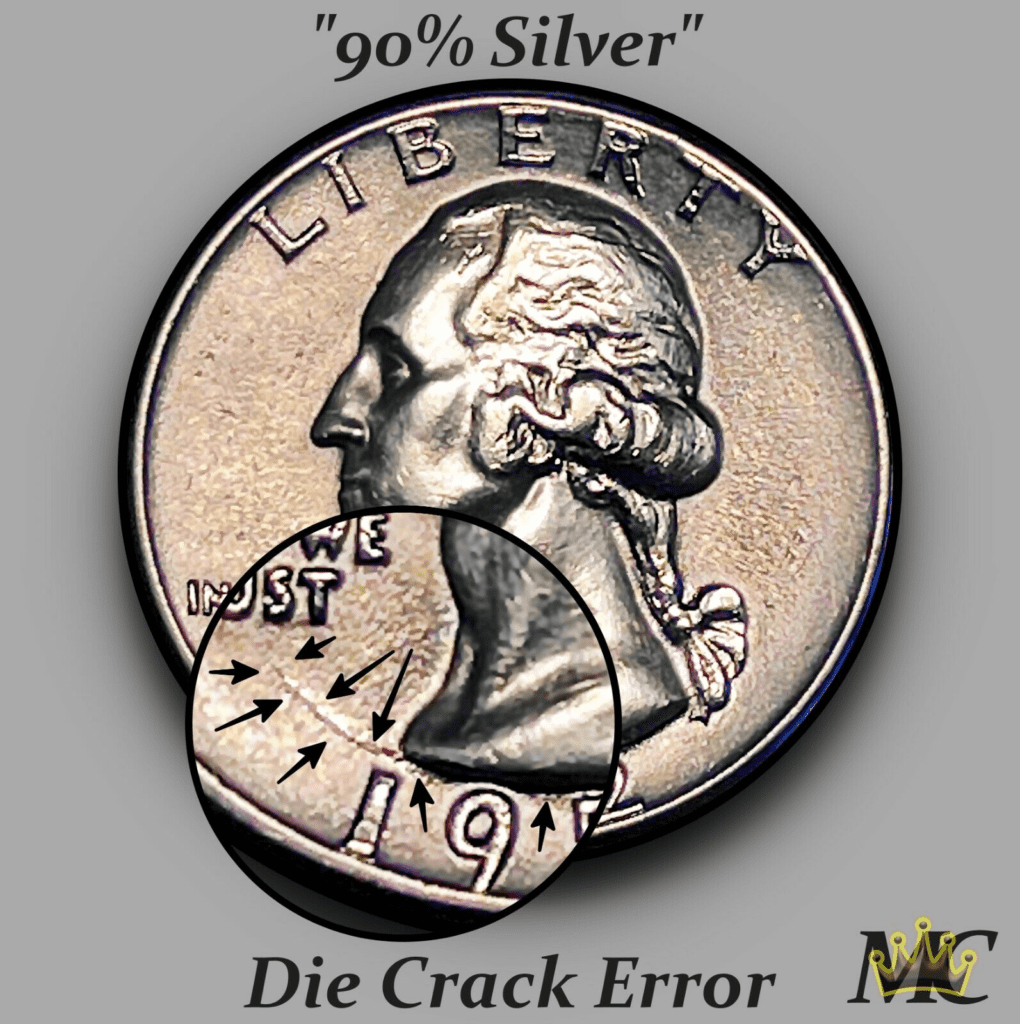
Repunched mintmark
The repunched mintmark (RPM) happens when the mintmark is punched to the planchet twice. There are even times when it is punched more than twice.
RPMs could cause a doubling or blurring of the mintmark. As you may know, the repunched mintmark is punched to the coin separately. So, you may see this error on the mintmark but not on the rest of the coin.
Here’s an example of an RPM error:
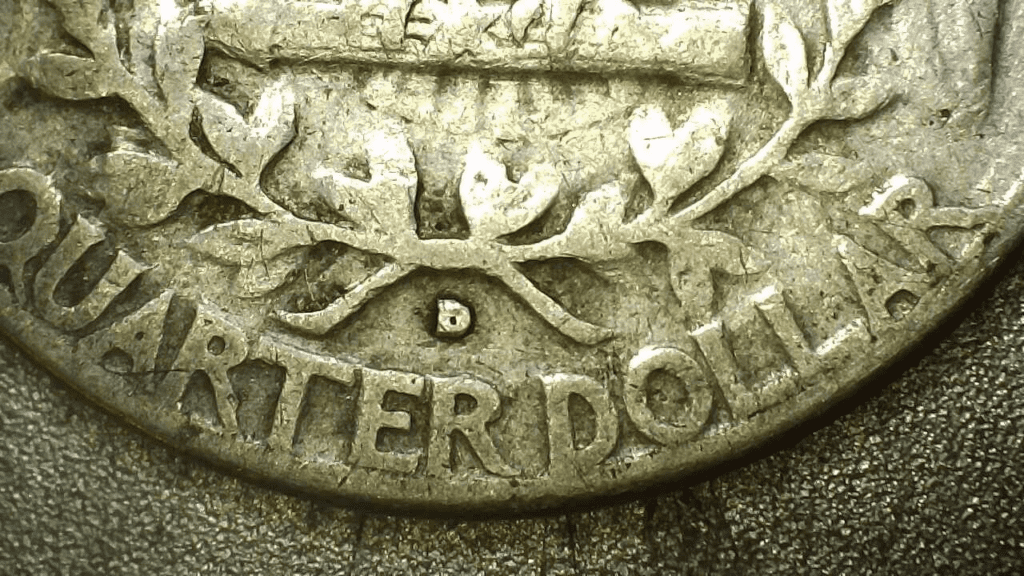
How Much Is The 1952 Washington Silver Quarter Worth Today?
As its name suggests, the 1952 Washington silver quarter has a face value of 25 cents. However, its melt value is higher, reaching up to $3.9714 since it is made of silver. The melt value can also go up and down depending on the market price of silver. The price of a circulated 1952 silver quarter is also higher which starts at around $4.45 to $7.
You can also check this table to learn more about the auction records for each variety:
| Coin | Condition | Grade | Sold date | Sold by | Value |
| 1952 D Washington quarter | Superb Gem Uncirculated | MS 67+ | June 27, 2019 | Legend Rare Coin Auctions | $21,150 |
| 1952 S Washington quarter | Superb Gem Uncirculated | MS 68 | July 30, 2003 | Bowers & Merena | $15,525 |
| 1952 Proof Washington quarter | Superb Gem Uncirculated | PR 67 (Deep Cameo) | April 26, 2015 | Heritage Auctions | $8,519 |
| 1952 P Washington quarter | Superb Gem Uncirculated | MS 67 | October 25, 2010 | David Lawrence RC | $4,600 |
How Does The Grading System Work?
Grading the 1952 silver quarter involves the use of the Sheldon Scale, which is a 70-point grading system to help people know immediately the condition and possibly, the value of a coin.
The appraiser would take note of the color, luster, appearance, strike, and level of preservation of the 1952 silver quarter to determine its grade. Once the grade is identified, an adjective would also be attached to the grade for a better understanding of the condition of the coin.
A coin may also be labeled as MS or Mint State if the coin was originally made for circulation. A coin would receive the PR label if it is originally made as a proof coin.
Professional numismatists joined together in the 1970s and established CoinGrading standards. These numismatists now assign grades at key places on the seventy-point scale, using the most regularly utilized numeric points in conjunction with the original adjective grade. The following are the most common coin grades:
-
-
- (P-1) Poor – Indistinguishable and probably damaged; if used, must have a date and mintmark; otherwise, rather battered.
- (FR-2) Fair – Nearly smooth, but without the damage that a coin graded Poor often possesses. The coin must have enough detail to be identified.
- (G-4) Fair – Inscriptions have merged into the rims in some areas, and important elements have been mostly erased.
- (VG-8) Very Good- A little weathered, but all of the primary design elements are visible, albeit faintly. There is little if any, central detail left.
- (F-12) Good – The item is very worn, yet the wear is even, and the overall design details stand out clearly. Rims are almost completely isolated from the field.
- (VF-20) Very Fine – Moderately weathered, with some finer features still visible. The motto or all letters of LIBERTY are readable. Both sides of the coin have entire rims that are separated from the field.
- (EF-40) Extremely Fine – Gently used; all gadgets are visible, and the most important ones are bold. The finer details are bold and clear, however, light wear may be seen.
- (AU-50) Uncirculated – Slight evidence of wear on the coin’s design’s high points; may have contact marks; eye appeal should be adequate.
- (AU-58) Uncirculated Choice – Slight traces of wear, no severe contact marks, almost full mint shine, and great eye appeal.
- (MS-60) Mint State Basal – Strictly uncirculated; no indication of wear on the coin’s highest points, but an unsightly coin with reduced luster, visible contact marks, hairlines, and other flaws.
- (MS-63) Mint State Acceptable – Uncirculated, but with contact scratches and nicks, little reduced shine, but otherwise appealing appearance. The strike is weak to average.
- (MS-65) Mint State Choice – Uncirculated with great mint shine, very little contact blemishes, and exceptional eye appeal. The strike is unusually severe.
- (MS-68) Mint State Premium Quality – Uncirculated with superb luster, no obvious contact marks to the naked eye, and exceptional eye appeal. The strike is quick and appealing.
- (MS-69) Almost Perfect Mint State – Uncirculated with perfect brilliance, a sharp and appealing strike, and extremely good eye appeal. A near-perfect coin with minor imperfections in the planchet, strike, and contact markings (seen only under 8x magnification).
- (MS-70) Mint State Perfect – Under 8x magnification, there are no tiny imperfections discernible; the strike is crisp, and the coin is perfectly centered on a beautiful planchet. Rarely seen on a coin, this coin is bright and whole, with original luster and exceptional eye appeal.
-
Where To Buy Or Sell 1952 Washington Silver Quarter?
The 1952 Washington silver quarter is available online. Some of the websites you can go to include Amazon, eBay, Etsy, USA Coin Book, Grey Sheet, and Coin Appraiser. All of these websites would allow you to both buy and sell coins.
If you want to buy or sell in person, some of the places you can go to include coin shops, pawnshops, antique stores, and auction houses.
FAQs
Is a 1952 quarter pure silver?
The 1952 quarter is not pure silver. Instead, it is made of 90% silver and 10% copper.
Where is the mint mark on a 1952 silver quarter?
The mint mark on a 1952 silver is found on the reverse side of the coin. You can find the mint mark just below the olive branch and above the second letter R of the word Quarter. You should find a mintmark that can either be S or D.
How many grams of silver are in a 1952 quarter?
The 1952 quarter has 5.12559378 grams or 0.1808 oz of silver, which is also known as its Actual Silver Weight (ASW).
